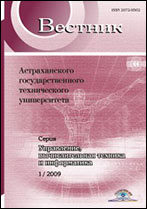|
TELECOMMUNICATION SYSTEMS AND NETWORK TECHNOLOGIES
Procedure of selecting a cluster head node in a wireless sensor network using fuzzy logic
E. A. Efstifeeva, V. D. Semeikin
Astrakhan State Technical University
Abstract:
Clustering, as one of the energy-efficient approaches, is widely used in wireless sensor networks. This method is based on creating clusters and selecting cluster head nodes in a wireless sensor network. Clustering saves network energy because data transfer is restricted between multiple nodes. Thus, clustering is provided between several nodes, and the service life of the wireless sensor network can be extended. Since the parent cluster node interacts with other nodes of the network, a node with a high level of residual energy must be selected to perform this role. When the energy level of the selected cluster head node becomes lower than the threshold value, then the re-election of this node takes place. It should be noted that multiple patterns of choosing cluster head nodes built using various parameters (residual node energy, distance from the base station to a node, distance between the head node and a cluster member, the number and proximity of neighboring nodes, etc.) lacked for a factor of energy consumption, i.e. how many times nodes communicated to each other. To cope with the problem, this paper presents a prognostic algorithm for selecting a cluster head node using fuzzy logic. This algorithm suggests using a number of input parameters, such as the residual energy of the node, the proximity of neighboring nodes, and the centralization of the node in the cluster. The proposed algorithm has been implemented using the software package MATLAB Fuzzy Logic Toolbox. The simulation results prove the advantages of the proposed technique; application of the input parameters mentioned above helps select optimal cluster head nodes in a wireless sensor network, which increases power efficiency of a wireless sensor network.
Keywords:
algorithm; probability; energy efficiency; wireless sensor network; clustering; cluster head node; fuzzy logic, MATLAB.
Received: 11.12.2017
Citation:
E. A. Efstifeeva, V. D. Semeikin, “Procedure of selecting a cluster head node in a wireless sensor network using fuzzy logic”, Vestn. Astrakhan State Technical Univ. Ser. Management, Computer Sciences and Informatics, 2018, no. 1, 81–89
Linking options:
https://www.mathnet.ru/eng/vagtu520 https://www.mathnet.ru/eng/vagtu/y2018/i1/p81
|

| Statistics & downloads: |
| Abstract page: | 285 | | Full-text PDF : | 93 | | References: | 28 |
|




 Contact us:
Contact us: Terms of Use
Terms of Use
 Registration to the website
Registration to the website Logotypes
Logotypes








 Citation in format
Citation in format 